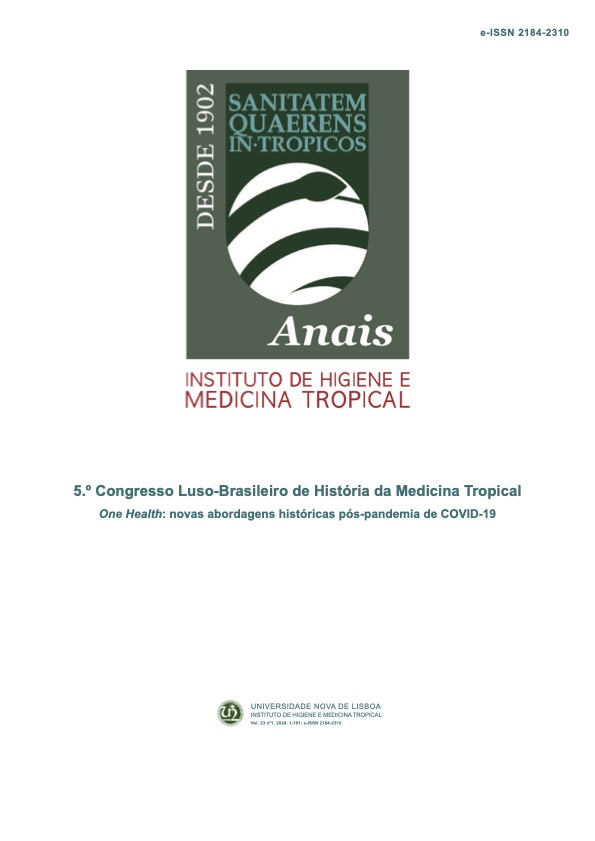Bauru and its ulcer: the Brazilian Northwest railroad – NOB – and the city’s sanitary conditions from the look of the press (1916 and 1930)
Abstract
In the context of the broader reflection on the theme “One health, new historical approaches after COVID-19”, we seek to bring a theme that illustrates the intimate relationship between human health, the animal world and the environment, which is part of the history of tropical medicine, and, in particular, the history of Leishmaniasis. This work aims to analyze the relationship between the construction of the railway line in the northwest region of the State of São Paulo, in Brazil (NOB) (starting in Bauru) and the sanitary conditions of the city, published in the generalist press of the State of São Paulo, O Bauru and Diario da Noroeste, between 1916 and 1930. The city was born around coffee production, which catapulted the construction of the Railway, starting in 1906. This railway line crossed half of the State of São Paulo, and the southern region of Mato Grosso, to the city of Corumbá on the Bolivian border with an approximate length of 1400 kilometers. The destruction of native forests allowing the proliferation of the straw mosquito – Lutzomia – started the proliferation of Leishmaniasis named after the NOB headquarters city, Bauru. The city’s precarious hygiene conditions between 1916 and 1930, despite the opening of hospitals, allowed the Bauru ulcer to spread, as well as other diseases, leading to a scenario of great concern in the context of public health in Brazil and the history of Leishmaniasis on a global scale.
Downloads
References
Domingues LP, Fernandes E. Fronteira Infinita: índios, bugreiros, escravos e pioneiros na Bahurú do século XIX. 1.ed. Bauru: Universo Elegante Produção Cultural; 2018. 191p.
Moratelli T. Operários da empreitada: os trabalhadores da estreada de ferro Noroeste do Brasil (São Paulo e Mato Grosso, 1905 – 1914). 1. ed. Campinas: Editora da Unicamp, 2013. 272p.
Lei de Terras – Número 601 de 18 de setembro de 1850. [Internet]. 1850.[citado 2024 mar 01].
Queiroz PR. Uma ferrovia entre dois mundos: a E. F. Noroeste do Brasil na primeira metade do século 20. 1.ed. Bauru: EDUSC; Campo Grande: UFMS. 2004. 528p.
Castro, MI. O preço do progresso: a construção da Estrada de Ferro Noroeste do Brasil (1905-1914). [internet] [Dissertação de mestrado]. Campinas: Instituto de filosofia e Ciência Humanas/Unicamp;1993 [citado 2024 mar.01]. Disponível em: https://repositorio.unicamp.br/acervo/detalhe/62549
Benchimol JL, Da Silva AF. Ferrovias, doenças e medicina tropical no Brasil da Primeira República. [Internet]. 2008.[citado 2024 mar 01]. História, Ciências, Saúde – Manguinhos. 15 (3): 719-762. Disponível em: https://doi.org/10.1590/S0104-59702008000300009
Camargo LM, Barcinski MA. Leishmanioses, feridas bravas e kalazar. Ciência e Cultura. 2003; 55(1): p. 34-37.
“É desaforo”. O Bauru, 02 de jul. 1916, p.1.
Pinheiro B. “O estado sanitário da noroeste – a lenda da úlcera de Baurú”. Diario da Noroeste, 27 de mai. 1926, p.1.
Pinheiro B. Diario da Noroeste, 28 mai. 1926, p.1.
Communicado da Inspectoria Sanitaria de Baurú. Vaccinação contra Varíola. Diario da Noroeste, 20 de ago. 1925, p.1.
Um novo tratamento para a Leishmaniose. Diario da Noroeste, 18 de mai. 1926, p.1.
Amaral IM, Diogo MP. Introdução. In: Amaral IM, Diogo, MP. A outra face do Império: ciência, tecnologia e medicina (sécs. XIX e XX), Coordenadores. Lisboa: Edições Colibri. 2012. p.07-16.
Jogas Junior DG. Leishmaniose tegumentar americana em perspetiva histórica e global (1876-1944). [internet] [Tese de Doutorado em História das Ciências e da Saúde] Rio de Janeiro: Fundação Oswaldo Cruz. 2019. 281p. [citado 2024 mar.01]. Disponível em:https://www.arca.fiocruz.br/bitstream/handle/icict/50328/va_Denis_Jogas_Junior_COC_2019.pdf?sequence=2&isAllowed=y
Mota A, Schraiber LB. A Leishmaniose pelos sertões paulistas: uma longa endemia. In: Mota A. Os Sertões Paulistas: medicina, saúde pública e a invenção do território. 1ª ed. São Paulo: Alameda, 2021. 467p.
Goodland RJ, Irwin SH. A selva amazônica: do inferno verde ao deserto vermelho? Tradução de Regina Regis Junqueira. São Paulo: Itatiaia; Ed. Da Universidade de São Paulo, 1975. 160p.
Deutsche Welle [internet]. Brasil. Entrevista. Nádia Pontes com o cientista Carlos Afonso Nobre – Cientista Carlos Nobre fala sobre “enorme risco” de a Amazônia sumir; c2022 [citado 2024 mar.01]. Disponível em: https://www.youtube.com/watch?v=kjsYwbh7kTY&t=166s

This work is licensed under a Creative Commons Attribution 4.0 International License.





